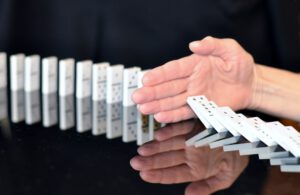PMR: What is that?
Progressive muscle relaxation (PMR) is used to reduce anxiety. The technique was introduced by the American doctor Edmund Jacobson in the 1930s. This technique alternates tension and relaxation of all the body’s important muscle groups. In this way, PMR gradually achieves a state of relaxation. With increasing practice, more and more muscle groups can be relaxed simultaneously, even without prior tension.
If you struggle with cPTSD or an anxiety disorder, your muscles are probably often tense. Then PMR will help you not only to relax but also to learn how a relaxed muscle feels different from a tense one. If you use this technique correctly, you may even fall asleep while doing it. Then you can congratulate yourself on reaching such a deep state of relaxation and be proud of the success of your work up to this point. Progressive muscle relaxation is used alone or with other techniques, such as thought-stopping or grounding exercises. But even if you use PME alone, you will gain a better sense of your body’s fear response and how to control it.
PMR: Steps of progressive muscle relaxation
Find a quiet place where you will not be distracted. Lie on the floor or lean back in a chair, loosen any tight clothing and take off your glasses. Breathe slowly and evenly a few times. If you haven’t already done so, practice belly breathing for a few minutes.
PMR: Abdominal Breathing
To do this, place one hand on the upper chest and the other hand on the abdomen below the rib cage. Allow your belly to relax without forcing it inwards by clenching or tensing the muscles. Breathe in slowly through your nose. Breathe out slowly through the slightly compressed lips. Feel your abdominal wall rise and fall with your hand. The hand on your chest should remain motionless.
PMR: Technique
Now place your hands in your lap or on the armrests of your chair. Focus your attention on the following areas, ensuring that the rest of your body remains relaxed: Hands, arms, shoulders, neck, face, back, chest, abdomen, buttocks, legs and feet.
o Tense each muscle group from weak to strong for about 15 seconds. o Then, release and consciously perceive the relaxation for about 30 seconds. o Repeat the process once for each muscle group. o Then, enjoy the relaxation of the entire body. o After the exercise, activate if you do not want to rest or sleep: stretch like a cat and tense all muscle groups one after the other.
PMR: Example
Close your right hand into a fist (15 s) and pay attention to the tension in your forearm and hand. Now let your hand and forearm relax, very loosely (10 s). Notice how your hand and forearm muscles relax more and more (10 s). Try also to let your fingers become completely loose (10 s). And now close your right hand into a fist once more. Hold the tension again. Now give in and watch the transition from tension to relaxation (10 s). Observe the different sensations carefully during tension and relaxation (5 s). Repeat this exercise with the left hand.
PMR: Muscle groups
As can be seen in the example, tension and relaxation are performed twice for each muscle group and side.
Forehead: Squeeze the muscles of your forehead and hold for 15 seconds. Feel the muscles getting tighter and tighter. Then slowly release the tension in your forehead, counting for 30 seconds. Notice the difference in how your muscles feel when you relax. Continue to release the tension until your forehead feels completely relaxed. Breathe slowly and evenly.
Jaw: Tense the jaw muscles and hold for 15 seconds. Then slowly release the tension, counting for 30 seconds. Feel the sensation of relaxation and continue breathing slowly and evenly.
Neck and shoulders: Increase tension in the neck and shoulders by pulling the shoulders up towards the ears and holding for 15 seconds. Slowly release the tension while counting for 30 seconds. Feel the tension release.
Arms: Slowly clench both hands into fists. Pull the fists towards your chest and hold them together as tightly as possible for 15 seconds. Then slowly release while counting for 30 seconds. Feel the sensation of relaxation.
Buttocks: Slowly increase the tension in your buttocks over 15 seconds. Then slowly release the tension over 30 seconds. Feel the tension release. Continue to breathe slowly and evenly.
Legs: Slowly increase the tension in your quadriceps and calves over 15 seconds. Tighten the muscles as much as you can. Then gently release the tension over 30 seconds. Notice how the tension eases, and the feeling of relaxation remains.
Feet: Slowly increase the tension in your feet and toes. Tense the muscles as much as you can. Then slowly release the tension while counting for 30 seconds. Feel all the tension disappear. Continue breathing slowly and evenly.
No matter what kind of anxiety plagues you, studies prove that PME is an evidence-based and effective technique for anxiety reduction.
Sources:
Stemper, D.: Workbook SELBSTFINDUNG & SELBSTORGANISATION FÜR FÜHRUNGSKRÄFTE – ERFOLGREICHE MITARBEITERFÜHRUNG MIT EMPATHIE & WERTEN. DAS MINDSET FÜR DIGITAL LEADERSHIP.
Jacobson E.: Progressive relaxation (2nd ed.). Chicago: University of Chicago Press 1938
Bermejo Caja CJ, Martín García Á, García Laborda A, Pérez Quintana M, Díaz Rodríguez L, Marqués Andrés S.: Effectiveness of relaxation on anxiety and quality of life in adult patients with generalised anxiety disorder: a systematic review protocol. JBI Database of Systematic Reviews and Implementation Reports. 2013;11(1):270 – 287
Pagnini F, Manzoni GM, Castelnuovo G, Molinari E.: A brief literature review about relaxation therapy and anxiety. Body, Movement and Dance in Psychotherapy. 2013;8(2):71-81. doi:10.1080/17432979.2012.750248
Manzoni GM, Pagnini F, Castelnuovo G, Molinari E.: Relaxation Training for Anxiety: A Ten-Year Systematic Review with Meta-Analysis. BMC Psychiatry. 2008;8:41. doi:10.1186/1471-244X-8-41
Jorm AF, Christensen H, Griffiths KM, Parslow RA, Rodgers B, Blewitt KA.: Effectiveness of complementary and self-help treatments for anxiety disorders. Med J Aust. 2004;181(7 Suppl):S29-46. doi:10.5694/j.1326-5377.2004.tb06352.x




